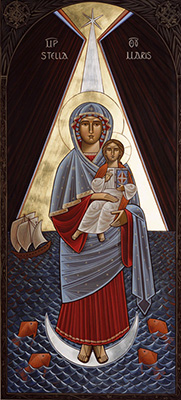Stella Maris
Stella Maris
Stella Maris — The Apostleship of the Sea

Stella Maris (The Star of the Sea) has long been the favourite title by which people of the sea have called on her in whose protection they have always trusted: the Blessed Virgin Mary. Her son, Jesus Christ, accompanied his disciples in their vessels, helped them in their work and calmed the storms. And so the Church accompanies seafarers, caring for the special spiritual needs of those who for various reasons live and work in the maritime world. – Pope John Paul II
The Sea covers two thirds of the planet and the people of the sea, those who live, work or have their present or past way of life linked in any way to the sea are served by the Church through the Apostleship of the Sea (AOS). The AOS is often known locally as Stella Maris after the name given to the many seafarers hostels provided in ports around the world.
The AOS today has a presence in some 116 countries and is striving to serve many millions of people. These are people who may always be on the move or who may be shore based. These are people involved in the international seafaring and coastal seafaring trades, in commercial fishing and in subsistence fishing communities, in the offshore oil industry or in the cruise shipping industry plus the many contract sailors employed in yachting around the world. Our Lady Star of the Sea is the patron of the AOS and all those who contribute to this work of serving the People of the Sea.
This Icon of our Lady Star of the Sea was painted in the Neo-Coptic style by the internationally renowned iconographer Dr. Stephane Rene who is the only exponent of this sacred artistic tradition in the West.
The Coptic icon is the direct heir to the spirituality of the Desert Fathers who were the first Christian Monks (Coptic period second to seventh centuries) and lived in the deserts of the Middle East. They led a prayerful and reflective way of life and developed a spirituality which shaped many monastic rules such as that of St. Benedict. St. Jerome was a Desert Father and he identified in his writings that Mary, the Mother of God, was the Star of the Sea.
The Star of the Sea is the most ancient of titles for Our Lady. It is premised that in the time of Our Lord the equivalent phrase of Our Lady in the Aramaic language of that day meant pilot, leader or guide--someone who could navigate through the sea or the desert by the stars and lead people to safety. The stars were and are used as a guide to safety and to new life. The sea covers all the earth and symbolises all the people of the earth. Our Lady was therefore identified from the very earliest days of the Church as the guiding light to her son, Our Lord, for all the people of the earth.
The Icon of Our Lady Star of the Sea--Stella Maris
The Icon Stella Maris is set in the context of the night and reflects the difficulties of life sensed more deeply at night and perhaps also of the times of the dark night of our souls.The triangles are symbols of fire which in turn are symbols of the Spirit.
The star is Sirius, the largest and most brilliant star in the heavens. A major star of navigation but also known in mythology as the God Star or the Dog Star that leads. This star was (and is) an object of great worship in many cultures around the world. In the middle east the rising of Sirius in the heavens in June coincided with the annual floods of the Nile upon which the lives of the ancient Egyptians depended.
The visible circulation of the minor stars Sirius A and Sirius B around Sirius itself were also part of this worship culture and form the basis of the Star of David symbol.
The Virgin and Child are positioned in the upward pointing triangle of the Spirit--linking to Sirius the lead star of navigation Mary is herself the Star which illuminates our inner darkness and leads our souls to her divine Son.
The sea has always been the most feared elements of nature because of its enormous power to sustain life or destroy. We are powerless and insignificant in the midst of its rage. Yet in its benign aspect the sea is a source of untold beauty and nourishment for mankind. The sea is therefore a metaphor for life and its perils but also for its wondrous joy and beauty. The world-wide ocean also represents all the peoples of the world.
The four fish are a reference to the four Gospels, and ultimately Christ Himself who was know to the early Christians as the Great Fish (Ethos).
The boat in the background is a symbol of the individual soul of the believer on the spiritual path. This boat of life can be navigated safely by turning to Christ as guided by Our Lady star of the Sea, the star of our life.The boat is also an image of the Church Militant navigating through time, through life and to the promised land.
Our Lady is depicted standing on the moon, again an object of worship in ancient religions. The image also recalls the verse in Revelation Chapter 12. And there appeared a great wonder in heaven; a woman clothed with the sun, and the moon under her feet, and upon her head a crown of twelve stars.
All About Mary includes a variety of content, much of which reflects the expertise, interpretations and opinions of the individual authors and not necessarily of the Marian Library or the University of Dayton. Please share feedback or suggestions with marianlibrary@udayton.edu.
